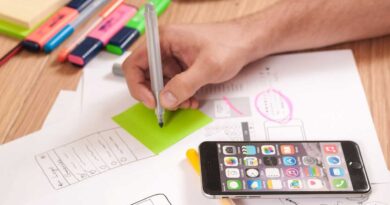How Mobile Apps Are Designed
150 thousand new applications are registered in the App Store and Google Play every month. Thoughtful design of mobile applications helps to attract users’ attention and achieve commercial success. Thus, according to research by McKinsey, companies with good design increase revenue by a third.
Appzur shares with you what knowledge and skills an application designer needs, how a mobile application is created, what needs to be taken into account when developing.
The app designer is responsible for the emotions of using the product. To accomplish this task, the designer must create not only an attractive visual appearance, but also be able to figure out user needs through research, draw up a navigation model (how application screens are connected), design an interface (prioritize the hierarchy of components).
What a mobile designer needs to know
Coloristics
The art of combining colors.
For example, it is not recommended to use green and red together – saturated colors that seem to shout over each other. The result is a torn-eyed interface, there is no contrast and objects are difficult to distinguish on the screen. For incongruous colors, designers have even come up with the definition of “green” (green + blue).
To select a color, special palettes or color wheels are often used – for example, Material palette, Adobe Color.
You can also take note of the palette of finished products. For example, in America there is a certain cult of sneakers, where they are bought not to replace an old pair, but rather from an aesthetic point of view. Therefore, some examples can be called a source of inspiration for designers who use sneaker color schemes for their products.
Typography
The ability to design text using typing and layout.
In essence, design is the design of content, 80% of which is conveyed through text. Any information is arranged in the form of a hierarchy – the main and secondary parts, which are highlighted using a certain styling of the text.
For example, heading levels — a 1st or 2nd level heading — vary in font size and serve as navigation and structured material.
Left alignment gives the text a neat look and is easier to read. Lines begin at the same level, and the eye quickly finds the beginning of the next line – convenient and quick to get used to.
Composition
The ability to competently manage objects in space. What are the dimensions of the object, the spacing between objects and the edges of the screen, the distance and connections between objects, will create a harmonious composition for better perception of objects?
When it comes to how color, typography, and composition affect user behavior and interface performance, there are four types of workloads worth mentioning.
Cognitive loads are efforts that we apply to recognize an object, the logic of its work and decide on further actions. For example, we understand that we have a button in front of us, not a rounded rectangle, and you can click on this button to get to the desired screen.
The more effort it takes for the brain to identify an object, the more we get tired.
Visual loads – efforts to identify an object on the screen by visual signs (circle, sky, cat) and distinguish it from others.
The more objects in the interface, the more we get tired.
Motor loads – occur during physical contact with the interface: swipe, tap, and others.
The more gestures to control the interface and the more complex they are, the more we get tired.
External loads – arise when the user interacts with the application (the dog barked, the car passed, it rained). These workloads are difficult to predict exactly – you can only guess under what conditions the application will be used most often.
The more distractions, the more we try to focus and the faster we get tired.
All types of loads go together, influencing each other.
For example, if the application is intended for firefighters who are often in stressful situations, you need the most understandable interface – they do not have time to understand something complicated. And if the user is an office employee who logs into the application to kill time on the way to work, then you can add more content or functions so that the user can get carried away and spend more time in the application.
Tools
From graphic editors, Figma, Sketch or Adobe XD are now popular.
- Figma
Cross platform online editor that works on Windows, macOS, Linux. The whole team can work in it, including with customers. Free for one user and paid for working with a team if you need to see all the team’s actions, not just the last 30 days.
- Sketch
Paid graphics editor for macOS. The advantage of Sketch is that it has been on the market longer than Figma, so in some cases there are more opportunities and integrations for it. But if you are a freelancer, it will be difficult to work with clients, since it is not a cross-platform tool. You can work offline in Sketch.
- Adobe xd
Adobe application for designing interfaces. The pros and cons are similar to Sketch, except that Adobe XD has the ability to create voice prototypes using Amazon Alexa. XD is noticeably less popular compared to Figma and Sketch.
Other designer tools include:
- Miro
In this service, it is convenient to do brainstorms, discussions, work out hypotheses, design navigation using a mindmap and create a Customer Journey Map.
Prototyping services
In addition to built-in prototyping in Figma, Sketch or Adobe XD, they additionally use solutions such as InVision, Marvel, ProtoPie, Flinto, Principle for Mac.
Development goals and objectives
The designer must understand what the business has to do and for whom the application is intended.
An application is a business tool with its own goals and objectives.
Soft skills
For example, more than half of your working time you communicate, coordinate, discuss. It is worth remembering that continuous communication can lead to professional burnout, so periodically you need to listen to yourself.
Correct reaction to criticism
Designers are constantly criticized, and many are offended by this.
Treat everything with humor – it helps, among other things, to transform negativity into a good mood.




